Generative AI has become a hot topic after the ChatGPT release. The reason is mainly because previous groundbreaking technological leaps, such as the wide distribution of personal computers or the Internet, could only help realize one’s potential. In their turn, generative platforms introduced a dramatic change to what a specific individual can do. Such solutions can not only improve the way you perform routine tasks but also allow you to do things beyond your skill set, such as drawing or writing code.
It’s no wonder that businesses quickly recognized the importance and potential of generative artificial intelligence. However, since this technology is relatively new and complex, it may be challenging to understand how it functions, which tool better suits specific needs, and its possible drawbacks. Today, we’ll try to fix that.
What Is Generative Artificial Intelligence?
Let’s start with the basics. In machine learning, you train models by feeding them with data so that they can make some valuable predictions or generate new data based on what they learn. Suppose your goal is to predict earthquakes more accurately. In that case, you can gather all the info you have on these natural phenomena, such as seismic data, geodetic data, geological data, and historical data, and give it to the ML model. It can use these data and indicators to learn the complex and nonlinear relationships between the input variables and the output targets. Also, it can be used to identify the anomalies, trends, and precursors that may signal an impending earthquake.
In turn, generative artificial intelligence is a particular class of models designed by AI developers to create content following the user’s requests. It can process many different inputs and generate different outputs. For example, there are text-to-text, text-to-image, text-to-video, text-to-code, image and text-to-image, and other types of generative models.
How to Train Your Generative AI
Naturally, the next big question arises. How exactly do developers train their generative AI systems and make them recognize and create data? There’s not one, not two, but three primary approaches we’ll consider today.
The unsupervised learning approach implies that the data you feed to the model does not include any info on its answer correctness. You don’t provide the model with hints on categorizing this or that piece of data. Here, developers are focused on processing data sets to identify patterns that have some meaning for the user. Clustering, or simply speaking, grouping related data sets, is the commonly used technique here. It’s an actual human being whose task is to provide meaning to the grouped examples. There are multiple clustering algorithms, such as K-means, DBSCAN, Gaussian Mixture Model, BIRCH, Affinity Propagation, and Mean-Shift. The K-means clustering algorithm, for example, focuses on the proximity of examples to a centroid:
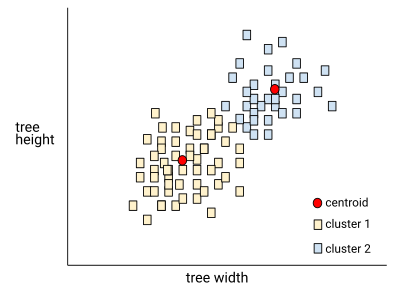
Source: Google for Developers
A human researcher can then breathe meaning into this data by labeling these clusters as “tiny little trees” and “big trees.” Also, models can use this learning approach for processing weather data sets, and then researchers can label specific clusters that better correspond to particular weather patterns:
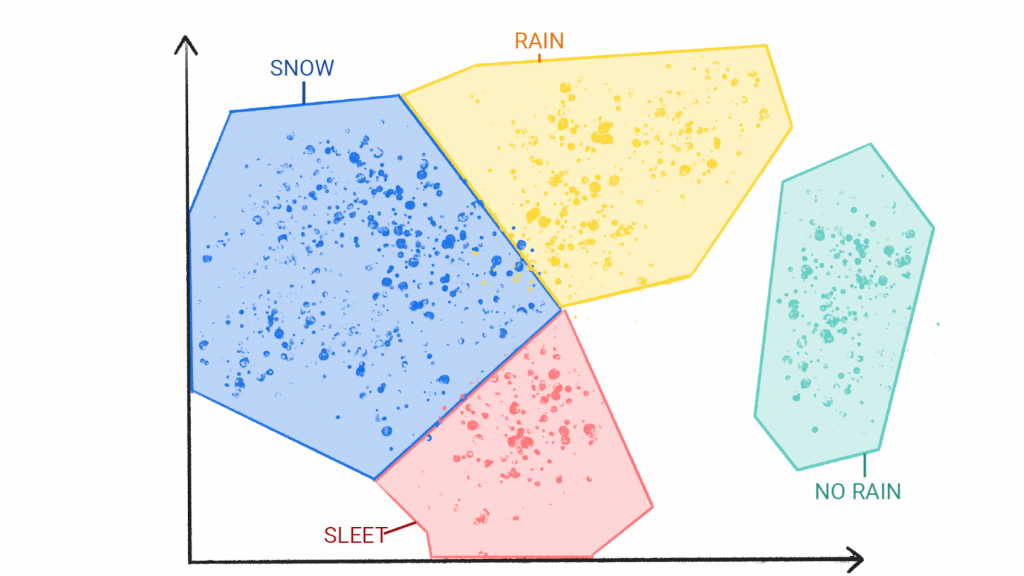
Source: Google for Developers
On the other hand, supervised learning processes large data sets and must be provided with correct answers to determine the connections between them and the data itself. Say you can use this technique to learn a model to recognize handwritten letters within a data set of images with labels indicating which letter is correct. “Supervised” means a real human being is required to provide these answers. There are two most common models used in supervised learning:
- The regression model is designed to predict continuous numerical values. For example, it can recognize the relationship between a dependent variable (rainfall volume) and one or more independent variables (temperature, humidity, and wind speed, affecting the rainfall);
- The classification model works with the probability of a specific entity belonging to a particular category. For example, it can predict whether a photo contains a tiger.
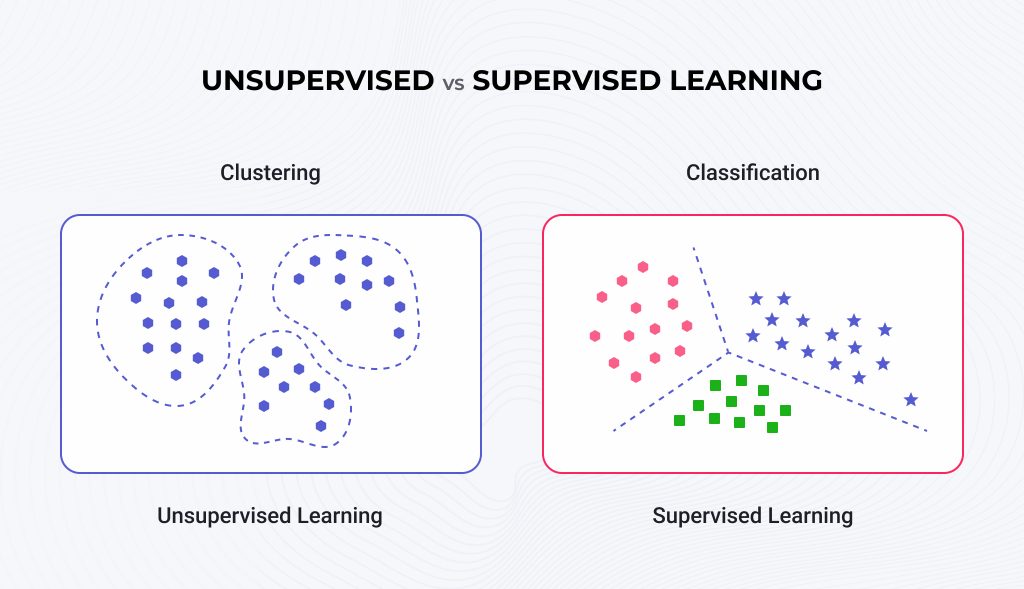
The reinforcement learning model will be the last one on our generative AI training techniques list. It works following the principle of rewards and penalties the system gets according to a specific action it performs to the environment. The system’s goal is to achieve maximum return. Therefore, it generates the most optimal policy as an embodiment of a strategy for getting the most rewards. For example, such systems can become expert players and achieve the maximum possible reward by learning all the previous sequences that lead to losses or wins.
Now, let’s see what types of generative artificial intelligence systems developers can build using these techniques.
What Types of Generative AI Are out There?
LLM, or Large Language Model, is a type of Generative AI that attracts the most attention and shows rapid devolvement. It’s an unofficial name for this kind of generative artificial intelligence system and usually refers to language models with a vast number of parameters, up to 100 billion in some cases. However, nobody actually knows at what point a language model becomes large.
Many modern generative artificial intelligence solutions that follow this approach, such as GPT, are based on Transformer architecture developed by Google. It relies on self-attention layers that can learn the relationships and dependencies between different parts of an input sequence, such as words, sentences, or images. LLMs are currently the most widely used and discussed type of generative AI. It has become especially evident after the launch of ChatGPT, which possibilities have blown everybody’s minds. However, there are other types of generative artificial intelligence systems.
GANs, or Generative Adversarial Networks, consist of two major components: a generator and a discriminator. The generator tries to create realistic data, such as images or videos. The discriminator’s task, in its turn, is to distinguish between real and fake data. The generator learns from the feedback of the discriminator and improves its outputs.
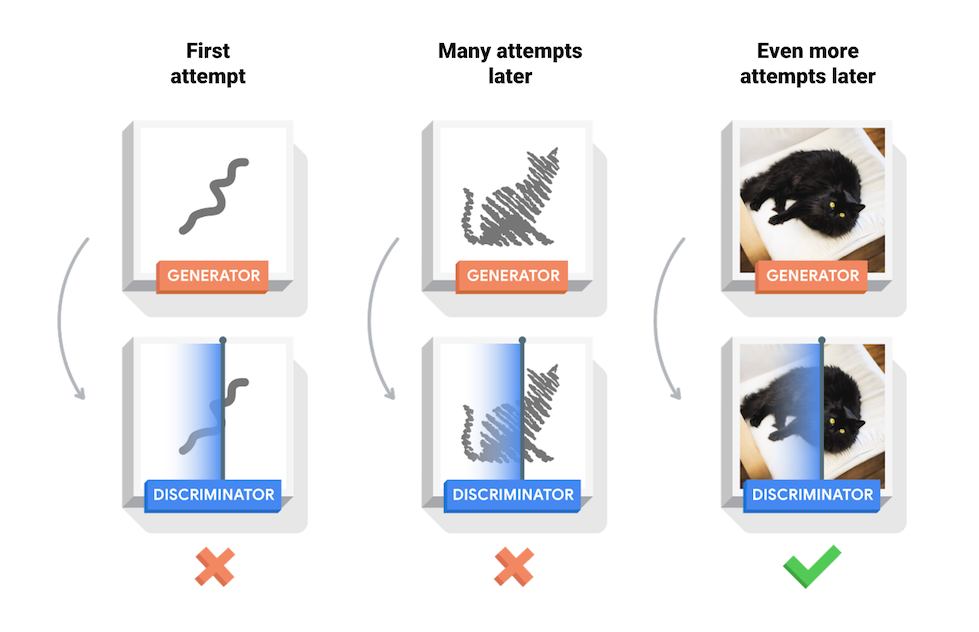
Source: Deep Convolutional Generative Adversarial Network Tutorial
Some examples of GANs are:
- DCGAN is one of the first GANs that achieved stable high-quality image generation. Also, it demonstrated the ability to perform vector arithmetic in the latent space, such as adding or subtracting attributes to images;
- CycleGAN can perform image-to-image translation, such as converting photos to paintings, horses to zebras, or summer to winter scenes. It does not require paired data but instead uses a cycle-consistency loss to ensure that the original image can be reconstructed from the translated image;
- StyleGAN can generate high-resolution and realistic images of human faces. Plus, it can adjust the style and variation of the output. This generative artificial intelligence uses a novel architecture that separates the latent space into coarse and fine features and introduces a style mixing regularization to enhance the diversity of the generated images;
- BigGAN can synthesize diverse, high-quality images of natural scenes and objects, such as animals, plants, and landscapes. It uses a large-scale data set, a large model capacity, and a class-conditional generation scheme.
VAEs, or Variational Autoencoders, are examples of generative artificial intelligence tools that learn the latent representation of data, such as images or text, and use it to generate new data similar but not identical to the original data. VAEs can also perform data compression, denoising, and interpolating tasks.Examples of this type of generative AI are:
- Convolutional VAE uses convolutional layers to encode and decode images;
- Text VAE uses recurrent layers to encode and decode text. It can generate sentences that are semantically and syntactically similar to the input sentences;
- Conditional VAE uses additional information, such as labels or attributes, to condition the generation process. It can generate images or text that satisfy certain criteria, such as style or sentiment.
Generative AI Applications in Different Industries
With so many approaches to learning from different types of data and various generative artificial intelligence solutions, it’s no wonder that they can become somewhat helpful in almost any industry. Let’s consider a few examples.
Healthcare
Virtual drug discovery. Instead of analyzing raw data, healthcare companies can use generative artificial intelligence to design entirely new drug molecules with desired properties, accelerating lead discovery. For instance, Insilico Medicine uses AI to create novel drug candidates, leading to promising preclinical results for Alzheimer’s disease. NVIDIA BioNeMo is a generative artificial intelligence platform for drug discovery. It accelerates the training of models using the data provided by the healthcare organizations and helps to scale their deployment for drug discovery applications.
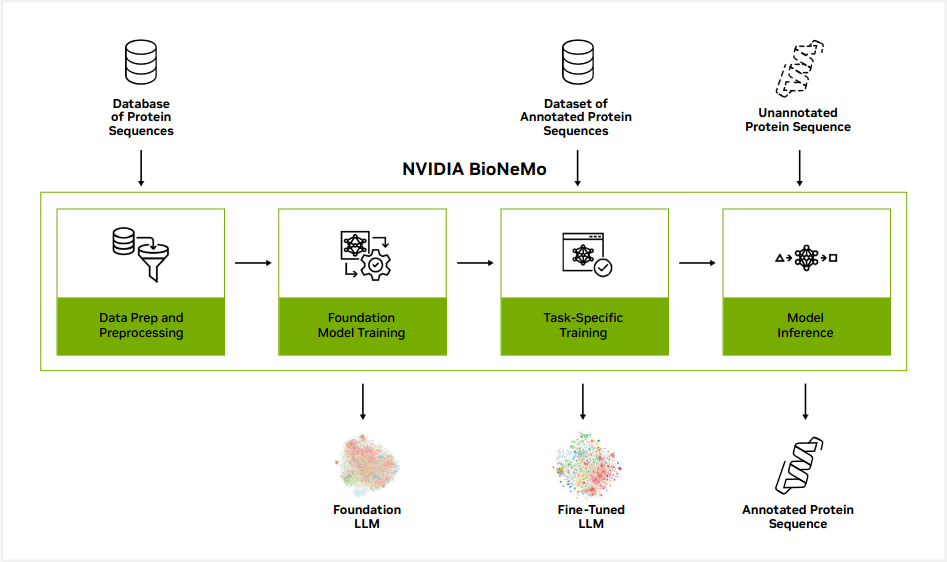
Source: Accelerate Drug Discovery With Generative AI
Medical imaging analysis. Generative AI can create synthetic medical images to train other AI systems, reducing dependence on patient data and addressing privacy concerns. PathAI, a company specializing in computational pathology, employs generative artificial intelligence to improve pathology diagnostics. They use GANs to generate synthetic pathology images. It helps augment the data set, providing the model with a broader understanding of variations and complexities in pathology specimens.
Marketing
Generative content creation. In addition to ML apps that can analyze data, generative artificial intelligence tools can create original marketing content like product descriptions, social media posts, and even videos tailored to specific target audiences. For example, Lumen5 uses artificial intelligence to generate video content from text and images, enhancing marketing campaigns.
Education
Adaptive learning platforms. Using Generative artificial intelligence to analyze data on student’s performance and learning styles, educational institutions can generate personalized learning pathways with tailored questions, practice problems, and content recommendations. This feature enables students to learn at their own pace and focus on areas that require improvement. Knewton is an adaptive learning platform that uses AI to analyze student data and create personalized learning programs with individualized questions.
Software Development
Automated testing. Software developers can use generative artificial intelligence systems to create diverse and dynamic test cases, uncovering edge cases and potential bugs that traditional testing methods might miss. Diffblue Cover uses artificial intelligence to generate unit tests for Java code automatically. It analyzes the codebase, understands its behavior, and creates tests to ensure code correctness and identify potential issues.
Self-writing code. While code completion tools like Copilot offer suggestions, generative models can write entire lines of code based on specific requirements, automating development tasks and accelerating software creation. For example, OpenAI’s Codex project demonstrates the potential for AI-generated code that surpasses simple suggestion functionality.
Supply Chain Management
Generative logistics planning. Supply chain software solutions can benefit from adopting generative AI tools as well. Such apps can optimize logistics plans by considering warehouse capacity and demand fluctuations. Aurora uses artificial intelligence to generate efficient truck routes, reducing transportation costs and emissions.
Inventory optimization. Generative artificial intelligence can predict future demand based on various factors, suggest optimal inventory levels for different products, and offer a list of suitable suppliers. Trax:ai can analyze vast amounts of data to identify and qualify potential suppliers based on specific needs and criteria. Generating a shortlist of reliable and suitable options, it streamlines the sourcing process and minimizes procurement risks.
Benefits and Drawbacks of Generative AI Adoption
Generative AI transforms the decision-making process previously entirely dominated by human intuition, intelligence, and analysis capability. Now, there are many more approaches to analyzing data, exploring possibilities, and ultimately choosing the best course of action. The way generative AI systems influence our decision-making, as it often happens, is a medal that has two sides. Let’s consider some potential benefits and drawbacks of making them a part of your toolset.
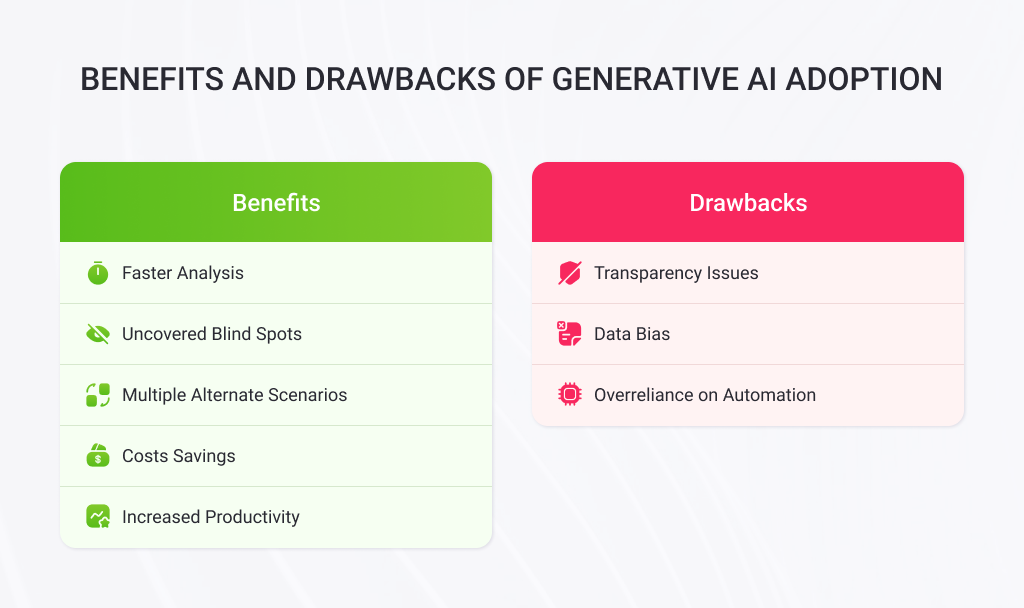
Benefits
Faster Analysis. Traditional data analysis relies on manual effort and interpretation, often requiring a series of time-consuming processes. Generative AI excels at sifting through massive data sets, uncovering patterns, and generating insights at mind-blowing speed. This feature empowers decision makers to react swiftly to changing circumstances and capitalize on opportunities. Say Google’s Gemini, which replaced Bard recently, can provide you with publicly available statistics on AR/VR device sales per region based on recent market research reports and industry estimations and export it to Google Sheets in no time.
Uncovered Blind Spots. Human prejudices and limited perspectives can become significant obstacles to comprehensive analysis. Generative AI doesn’t have such constraints and can explore vast data spaces, which enables access to insights that human analysts might have overlooked.
Multiple Alternate Scenarios. Forecasting the future is an intricate art. Generative AI specializes in modeling diverse scenarios, considering numerous factors and possibilities. It allows assessing the potential impact of different choices before committing, leading to more robust and adaptable strategies.
Costs Savings. According to The Hackett Group, adoption of generative AI can lead to 40% reduction in SG&A (selling, general, and administrative) costs within 5-7 years. This encompasses functions like finance, procurement, HR, and marketing. The actual ROI from generative AI will vary depending on your industry, specific use cases, and implementation strategy.
Increased Productivity. Generative AI streamlines repetitive tasks and fuels creative workflows, freeing up human workers for higher-value activities and boosting overall output. For example, McKinsey’s report “The economic potential of generative AI” shows that applying generative AI to customer care functions could increase productivity at 30-45% of current function costs.
Drawbacks
Transparency Issues. If you haven’t implemented and trained a generative AI system yourself, you’ll have to deal with a “black box.” This nature of some generative AI algorithms can raise concerns about transparency and explainability. Understanding how AI-driven decisions are reached and where the data comes from is crucial for building trust and ensuring ethical outcomes.
Data Bias. Generative AI is only as good as the data it’s trained on, and biased data can lead to biased outputs. Therefore, careful data curation and rigorous algorithm testing are crucial to mitigate potential biases and ensure fair and equitable decision-making.
Overreliance on Automation. Generative AI offers valuable assistance, but human intervention remains vital. Overreliance on AI-generated recommendations, without critical evaluation and contextual understanding, can lead to suboptimal or even dangerous outcomes. Maintaining a healthy balance between AI automation and human expertise is crucial to responsible decision-making. The overall enthusiasm around the ChatGPT launch made many people think that generative artificial intelligence can replace human employees completely. However, after the CNET decided to publish a dozen articles entirely synthesized by artificial intelligence, everything didn’t turn out as well as expected. For instance, an article about compound interest said a $10,000 deposit bearing 3 percent interest would earn $10,300 after the first year, while the correct answer is actually just $300.
Tips on Integrating Generative AI into Your Workflow
Since generative AI is no longer a science fiction artifact, many may decide to make it part of their businesses. Unfortunately, navigating the generative AI world can seem daunting for busy people. Considering the variety of forms this technology can take, it’s not a surprise. In this chapter, we’ll provide a small guide outlining key considerations to help you seamlessly integrate generative AI into your workflow and unlock its transformative potential.
Define Your Needs. Identify specific challenges where generative AI can add value. Do you need faster trend analysis, more diverse marketing content, or optimized logistics planning? Clearly defined goals guide your selection of tools and implementation strategies.
Choose Wisely. The generative AI landscape is vast, so you should research available tools based on your needs, budget, and technical expertise. You’ll probably decide to try ChatGPT first, which is a good starting point. However, remember that some generative AI tools are trained to solve a specific set of problems. An example is Jasper, an AI copilot for enterprise marketing teams.
Ethics Matter. Be mindful of potential biases in your data and algorithms. Ensure your generative AI solutions know how to synthesize the data you need, and also align with your ethical values, and address potential societal impacts.
Don’t Forget About Human Touch. Remember, AI is a tool, not a replacement. Train your team to understand generative AI capabilities and limitations and foster collaboration between human expertise and AI insights for optimal decision-making.
Start Small. Sometimes, small steps are better than giant leaps. Don’t try to revolutionize everything at once. Pilot a generative AI project in a specific area to assess its impact and gain valuable insights before broader implementation.
Stay Informed. The field of generative AI is evolving rapidly. Stay updated on new developments, explore emerging applications, and attend industry events to ensure you’re leveraging the latest advancements.
Measure and Iterate. Collect and track the data on the performance of your generative AI solution and measure its impact on key metrics. Continuously learn and adapt based on results, refining your approach and training your team for optimal outcomes.
Conclusions
Generative AI solutions are powerful tools for transforming decision-making. The technology is so versatile, and its implementations are so numerous that you may start thinking there’s a meta-generative AI that synthesizes them in such quantities. There’s nothing new here. A relatively new market is trying to fill all the niches, creating tools for all possible needs and budgetary possibilities. Such diversity makes it slightly more challenging to find the tool that suits your specific needs, but with some due diligence and our little guide, nothing will stop you from making the right decision. Contact us if you need a reliable team for developing your own custom AI software solution.